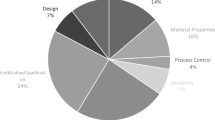Abstract
In strip rolling flatness of the final product is controlled inline with a roll sensor placed at the outgoing of the tandem mill to measure the longitudinal (in the rolling direction) internal stress profile throughout the coil. This profile involves resultant force and sometimes resultant moment (due to preset anomaly for example) equilibrated by the coiler. When strip is relaxed these two quantities are eliminated and there remain residual stresses in the strip. Since negative residual stresses are the main origin of defects, operators subtract the resultant force from measurements to visualize the residual stress profile in real time and detect negative values, without considering the resultant moment. In this paper we show that to predict flatness defects correctly we have to subtract resultant moment too. Otherwise, unpredictable defects manifest in the delivered product.




















Similar content being viewed by others
References
Molleda J, Usamentiaga R, García D (2013) On-line flatness measurement in the steelmaking industry. Sensors 13(12):10245–10272. https://doi.org/10.3390/s130810245
Abdelkhalek S, Zahrouni H, Legrand N, Potier-Ferry M (2015) Post-buckling modeling for strips under tension and residual stresses using asymptotic numerical method. Int J Mech Sci 104:126–137. https://doi.org/10.1016/j.ijmecsci.2015.10.011
Zahrouni H, Cochelin B, Potier-Ferry M (1999) Computing finite rotations of shells by an asymptotic-numerical method. Comput Methods Appl Mech Eng 175(1-2):71–85. https://doi.org/10.1016/S0045-7825(98)00320-X
Büchter N, Ramm E, Roehl D (1994) Three-dimensional extension of non-linear shell formulation based on the enhanced assumed strain concept. Int J Numer Methods Eng 37(15):2551–2568. https://doi.org/10.1002/nme.1620371504
Boutyour EH, Zahrouni H, Potier-Ferry M, Boudi M (2004) Bifurcation points and bifurcated branches by an asymptotic numerical method and Padé approximants. Int J Numer Methods Eng 60(12):1987–2012. https://doi.org/10.1002/nme.1033
Kanemori S, Kinose R, Maniwa S et al (2014) Development of strip shape meter with high accuracy under severe conditions of hot strip mill. Mitsubishi Heavy Ind Tech Rev 51:27–31
Molleda J, Usamentiaga R, García DF, Bulnes FG (2010) Real-time flatness inspection of rolled products based on optical laser triangulation and three-dimensional surface reconstruction. J Electron Imaging 19(3):31206. https://doi.org/10.1117/1.3455987
Tsuzuki S, Yoichi K, Kenji M (2009) Flatness control system of cold rolling Processwith pneumatic bearing type shape roll. IHI Eng Rev 42:54–60
Acknowledgments
Author wish to thank Arcelormittal company for providing measurements and Pierre Montmitonnet for helpful and comments on the paper.
Author information
Authors and Affiliations
Corresponding author
Ethics declarations
Conflict of interest
The authors declare that they have no conflict of interest.
Rights and permissions
About this article
Cite this article
Abdelkhalek, S. A proposal improvement in flatness measurement in strip rolling. Int J Mater Form 12, 89–96 (2019). https://doi.org/10.1007/s12289-018-1409-4
Received:
Accepted:
Published:
Issue Date:
DOI: https://doi.org/10.1007/s12289-018-1409-4




